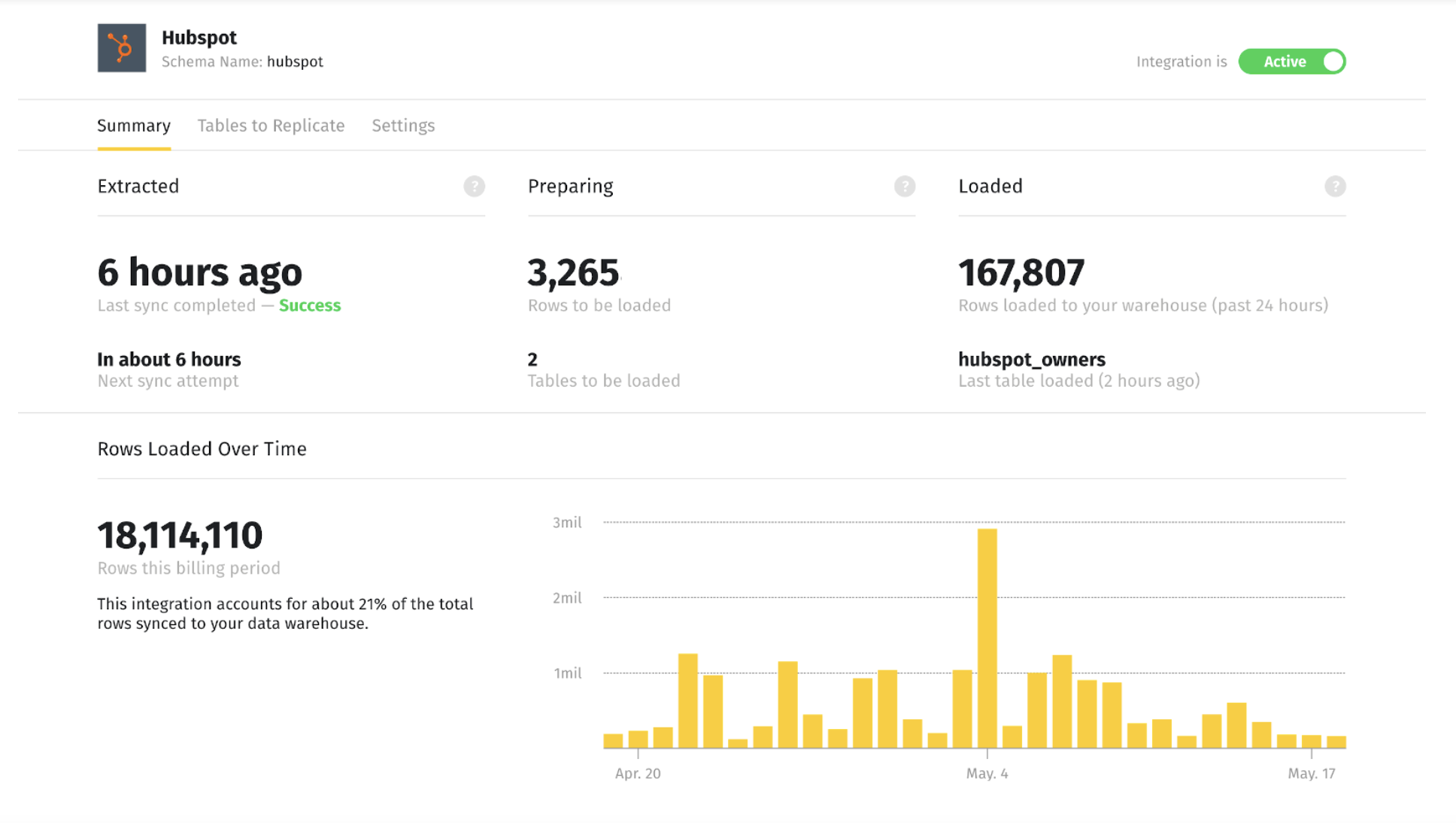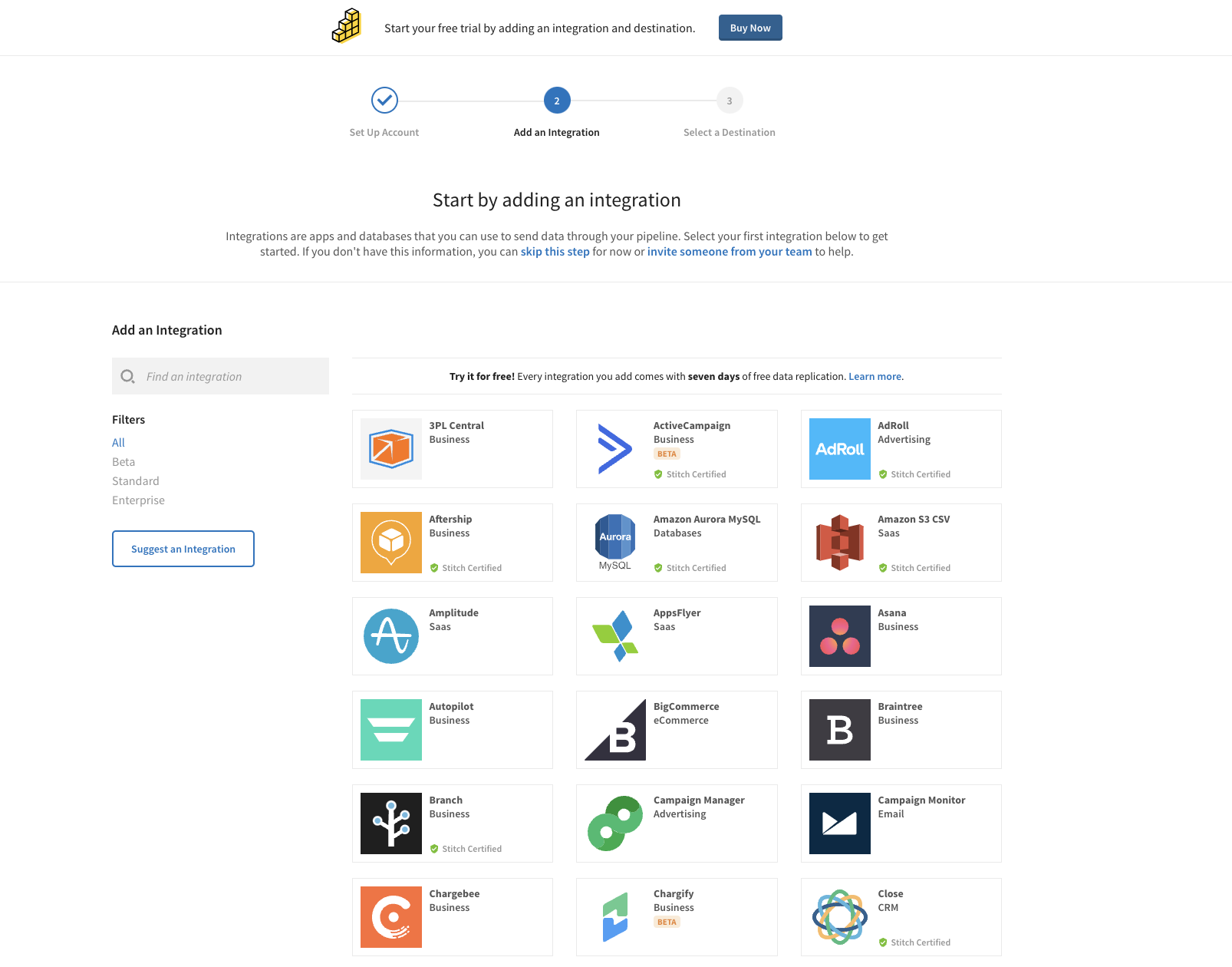Skip Navigation
Businesses generate lots of data — but most of them only use a fraction of what they collect to inform their strategy. Companies use about 200 different apps per department, and not every app integrates with one another. This data gap can represent massive business opportunities that would otherwise go unnoticed.
Data-driven strategy has become much more sophisticated, and many organizations now have dedicated data and research teams. Plus, marketing, operations, IT, and sales teams spend hours managing data from their own sources, often having trouble connecting the dots between departments.
The Stitch integration with HubSpot is an ETL service that can automatically replicate HubSpot data and add it to a data warehouse with data from all your other sources. And using this no-code system, any team members who are tech-savvy can monitor data health and freshness for the entire company in real-time.

Who can benefit from integrating Stitch with HubSpot?
Growing businesses, SaaS and ecommerce companies, and any teams managing data at scale can benefit from a simple way to aggregate all of their data in an easy-to-use platform. When data is available in a single place, teams can spend “more time surfacing valuable insights, and less time managing the data pipeline,” as Caitlin Moorman from Indiegogo, a Stitch user, puts it.
Why companies are turning to cloud data warehouses for analysis-ready data
Tools like Stitch automate data processes and can bring data from any platform, like other SaaS tools and databases (HubSpot included), into a cloud data infrastructure, ready for analysis. Not only is automated data processing a timesaver, but looking at the data from all areas of the business provides a deeper understanding of operations, and highlights areas for optimization.
Benefits of using Stitch with HubSpot include:
- Combining HubSpot data with data from your entire tech stack
- Accessing raw customer data without writing or maintaining ETL scripts
- Automating HubSpot data transfer into a cloud data warehouse for analysis
Sagar Velagala, Operations Manager at Lola says, “With Stitch in my data stack, instead of maintaining data pipelines I can focus almost entirely on delivering insights to every department at Lola at incredible scale.”
4 ways to use HubSpot and Stitch to enrich your data and uncover business growth opportunities
1. Gather all of your marketing business data in one place, and automatically sync data between HubSpot and Stitch using custom fields.
No more uploading, downloading, and aggregating data — sync HubSpot data into Stitch automatically and choose exactly what gets transferred with custom fields. Look at advertising exposure, CRM data, sales pipeline information, engagement points, and conversions all in one cloud data infrastructure.
Cross-reference HubSpot data with data from any other platform to find new partnership opportunities or engaged segments.
2. Gain a deeper understanding of sales data and improve sales strategy with predictive modeling, attribution, and cost studies.
Replicate HubSpot sales data into Stitch and monitor campaign performance. Merge offers, deals, touchpoints, calls, lead scoring data, contact info, billing, and conversion data with data points across the sales cycle that live outside of HubSpot.

3. Create custom, real-time dashboards, data visualizations, or reports with all of your business data from every tool for internal or external stakeholders.
Manual reporting leads to wasted time, errors, and burnout. It’s becoming more and more outdated by the day to manually pull reports, cross-reference data, and distribute analytics. Recent data even found that half of IT teams spend 5+ hours each week on repetitive business requests (that could probably be automated), and 90% of IT workers feel that manual and repetitive tasks contribute to low morale and higher turnover rates.
Use Stitch and HubSpot to build custom dashboards, data visualizations, or reports with business data from any platform. Share these dashboards between departments and with internal or external teams, breaking down silos and helping the organization grow more efficiently.
Dashboards help visualize the impact of business initiatives and show the value of every effort in the sales and marketing process. And, when you pull data directly into business intelligence or dashboard tools, your teams can save time and reduce ad-hoc data pull requests (translation: repetitive tasks).
“Stitch saves us a ton of time. Having a standard process to put the data in the warehouse and then feeding that data to a dashboard gives us more time to dig and uncover the story the data is telling us,” says Kristen Allcorn, Data Analyst at NextAfter.
4. Calculate the true ROI of sales and marketing spend.
With customer lifecycle data for the entire business in one platform, users can analyze big picture business performance, run predictive modeling, and create attribution reports. For revenue optimization and operations teams, data warehouses are useful sources for cost studies, and can speed up quarterly financial reporting.
Use combined data from HubSpot along with Salesforce, Google AdWords, Aftership, and others to calculate ROI on marketing and sales campaigns.

Ready to scale your growth using data you already have?
Here’s how users are leveraging the integration.
"Stitch supported important sources such as HubSpot, Intercom, and Mixpanel. Getting data into our database was seamless, and we've had to do little to no maintenance since then. The reliability has been great," says Sagar Velagala, Operations Manager at Lola.
Stan Zeehandelaar uses Stitch and HubSpot to build dashboards that his computer software team uses daily to measure important metrics for sales, customer success, and operations teams.
Miha Ambroz, in IT services, says, “Stitch takes the pain out of ETL and allows you to focus on the actual data, not the process of keeping it in sync. We’re using Stitch to populate our database and enrich HubSpot data by cross-referencing to other platforms.”
Set up the Stitch integration with HubSpot in minutes and enrich your HubSpot data in the data warehouse, no coding required.
Give Stitch a try, on us
Stitch streams all of your data directly to your analytics warehouse.
Set up in minutesUnlimited data volume during trial